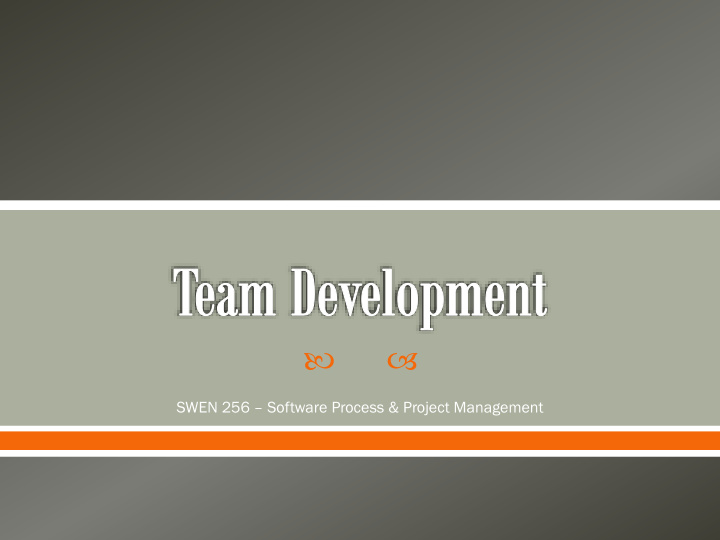



SWEN 256 – Software Process & Project Management
What are your responsibilities as a team member? As a Project Manager? How does Team Development relate to the Project Triangle? Scope Cost Schedule What’s more important? The strength of individual team members, or the strength of the team? What are some characteristics of a good team?
“Software projects fail for one of two general reasons: the project team lacks the knowledge to conduct a software project successfully, or the project team lacks the resolve to conduct a project effectively.” - Steve C McConnell
• Lack of • Communication • Identity • Recognition • Trust • Roadblocks • Bad Personnel (Classic Mistake) • Leadership? • Other reasons?
Start Project End Planning Enter Phase/ Exit Phase/ Initiating Closing Start Project Close Project Executing Monitoring and Controlling Team Formation
Kinds of teams: o Problem Resolution Team o Creativity Team o Tactical-Execution Team Team Models: o Business Team What types o Chief-Programmer (or surgical) Team of people do you need for o Skunkworks Team different o Feature Team teams? o Search-and Rescue Team, SWAT Team o Professional Athletic Team o Theater Team o Large Teams
Skills Skil ill Exampl ple e Activit ivity Planning Which resources are pre-assigned to the project? Negotiation Getting the best possible resources. Sharing resources. Hiring Outsourcing, virtual teams Risk Management What if resources become unavailable? Judgment Is it possible assumptions are being made regarding skill levels? Types of Influence Formal Reward Penalty (Coercive) Expert Referent (Legitimate) Leadership Styles Directing Facilitating Coaching Supporting Autocratic Consultative Consultative- Autocratic Consensus Delegating Bureaucratic Charismatic Democratic / Participative Laissez-Faire Analytical Driver Influencing
5 Self- Results Actualization 4 Esteem Accountability 3 Social Commitment Safety 2 Managed Conflict Physiological Trust 1 Individual Team Lower level needs must be satisfied before higher level needs can be addressed Patrick Lencioni’s “The Five Disfunctions of a Team”
“No matter how talented an individual may be, no matter how much energy he might possess, regardless of how much integrity and honesty he or she may have, if that person is alone, they can accomplish very little.” - Robert F. Kennedy(1964)
Trust Trust is the foundation oundation of teamwork Trust is all about vu vuln lner erabil ability ity, which is difficult for most people. Takes time. Needs to be maintained over time. Techniques – Behavioral profiling (like Myers- Briggs). Helps to ad admi mit t st strengths rengths & weak eaknesses nesses. “Overcoming the Five Dysfunctions of a Team”, Patrick Lencioni
Managed Conflict Good Good confli conflict ct among team members requires trust, which is all about engaging in unfiltered, passionate debate around issues. Even among the best teams, conflict will at times be un uncom comfor ortable table. Conflict no norms rms will vary in each team, and must be discussed and made clear. The fear of occasional personal conflict should not deter a team from having re regula gular, , pr productiv oductive e de deba bate. “Overcoming the Five Dysfunctions of a Team”, Patrick Lencioni
Conflict Resolution Techniques o Confronting (Problem Solving) o Compromising o Withdrawal (Avoidance) o Smoothing (Accommodating) o Collaborating o Forcing Problem Solving Define the real/root problem 1. Analyze the problem 2. Identify Solutions 3. Pick a Solution 4. Implement a solution 5. Review the solution, and confirm that it solved the problem 6.
Commitment Commitment requires clarity & buy buy-in in (McConnell – “signing up”) Clarity requires that teams avoid assumptions and ambiguity, and end discussions with a clear un unde derstand standin ing about what they’ve de deci cide ded upon. Buy-in does not requires consensus. Members of great teams learn to disagree with one another and still commit to a decision. “Overcoming the Five Dysfunctions of a Team”, Patrick Lencioni
Accountability Acco ccountabili untability ty on a strong team occurs directly among peers. For a culture of accountability to thrive, a lea leade der r must demonstrate a willingness to con confr front ont accountability. Best opportunity occurs during meetings and regular re revi view of accom accompli plishments shments. “Overcoming the Five Dysfunctions of a Team”, Patrick Lencioni
Project ect Project ect De Developer eloper Tes ester er 1 Manag nager er Spo pons nsor or 1 Activity 1 A I R Activity 2 R S Activity 3 C R S Activity 4 RA C Activity 5 A R S RACI – Responsible, Accountable, (Support), Consulted, Informed
Responsible: The person(s) assigned to do the work Accountable: The person(s) who has ultimate ownership of the results. Typically approves work Support: The person(s) who may be called upon to provide information or assistance Consulted: The person(s) who are consulted before a decision or action is taken Informed: The person(s) who shold be informed that a decision or action has been taken/completed
Results The true measure of a great team is that it accom acc ompli plishes shes the results it sets out to achieve. To avoid distractions, team members must pr prio ioriti ritize the results of the team over their individual or organizational (dept.) needs. To stay focused, team must publicly cl clar arify ify their desired results and keep them vi visi sibl ble. “Overcoming the Five Dysfunctions of a Team”, Patrick Lencioni
Formin rming: The group comes together 1. 1. and gets to initially know one another and form as a group. Stormi rming ng: A chaotic vying for Norming Storming 2. 2. leadership and trials of group processes No Norm rmin ing: Eventually agreement is 3. 3. Performing Forming reached on how the group operates Per erformin orming: The group practices its 4. 4. craft and becomes effective in meeting its objectives Di Diss ssolvin lving/ g/Adjou djourni rning ng 5. 5.
Recommend
More recommend